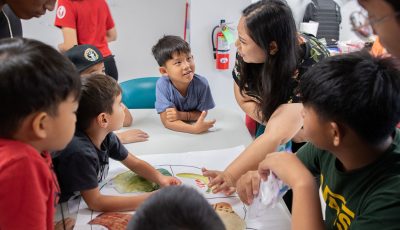HLI 18-12 is for more instructional materials, resources in public education
Public education spending per student in the CNMI “average 60 percent of the average per-pupil expenditure of their counterparts in the mainland.”
This means that for every dollar spent for public school students in the U.S., their counterparts in the CNMI—public schools students on Saipan, Tinian, and Rota—only spend 60 cents, an amount that is a combination of local and federal monies.
This level of local investment for public education is not enough to fund instructional materials and resources for public schools students, teachers and staff, and public schools in the CNMI.
This also means that there is not enough access to quality services and programs that can be availed of by public schools students. With House Legislative Initiative 18-12, public elementary, middle, and high school students will be able to avail of resources, materials, expertise and other forms of support to further sustain the growth of student learning.
Currently, PSS’ funding capacity limits the school district’s ability to be competitive and its ability to provide for a 21st century classroom environment that is currently present in its counterparts in the nation.
H.L.I. 18-12, once passed by voters this coming election, will primarily allow for increased classroom learning opportunities that currently is being supplemented by PSS’ share of federal monies.
For more than a decade now, per-pupil spending in the CNMI has been on a downward trend. As the cost per-pupil in the mainland United States increased from $ 8,378 in 2003 to $10,445 at the close of school year 2013-2104, the local per-pupil spending for public education was only at $3,306 and by the end of 2013-2014, it was pegged at $3,116 per-pupil.
Local budget
The funding for PSS is primarily spent in three equally critical areas vital to student learning.
The bulk of the PSS local appropriations is allocated to classroom teachers, staff, and personnel. Of the $32 million fiscal 2014 budget for PSS, $28.8 million was allocated to salaries and wages.
Another $2 million is allocated annually for water, sewer, and power for all 19 public school campuses, 10 Head Start centers, central office, and other PSS facilities.
A little over $2 million is left for “all others”—for operation and maintenance of all its facilities.
“The local funding we continue to receive as part of the government’s annual general appropriation is utilized to fund these critical areas. Essentially, our federal monies have assisted our school district to find better ways to improve student learning, by supplementing educational programs, resources, materials, trainings and improvements offered and provided by PSS,” Education Commissioner Dr. Rita A. Sablan explained.
Sablan pointed out that H.L.I. 18-12 will ease the challenge in funding additional programs and services for students to avail of much needed classroom resources, materials and support.
Accreditation finding
Improving classroom instruction has been central to PSS’ in building the overall capacity of its teachers and student. Although it is a growth in progress, at the onset of the 21st century, technology has changed classroom instruction dramatically.
PSS has also adopted and managed change to best serve its student.
PSS has also stepped up and implemented research-based instructional strategies and best practices to improve classroom learning and student outcomes.
However, with stringent and specific mandates in federal funding utilization, sustaining this direction for PSS hinges upon the need for more local investment in public education resources, instructional materials, and other support services.
AdvancED, the globally-recognized accrediting arm—which granted PSS the region’s first system-wide accreditation status—validated the need for more local investment in public education by citing the need for local funding support to public education.
“The efforts to engage students in their learning are spreading throughout the system but have not reached the level to be truly systemic in nature at this time. In order to achieve systematic and systemic approach to highly engaged student activities, the school system will need to provide its teachers with ongoing professional development and guide and support them along the way,” a portion of AdvancED’s 48-paged finding reads.
It added, “Resources is an area that will need to be addressed in order to achieve the vision and goals the Public School System has set for its students. The team observed several situations where lack of adequate resources make it difficult for the school system to provide the learning environment that students need to be prepared and successful for their future.”
With H.L.I. 18-12, PSS is able to sustain its research-based and data-driven curriculum and content standards that, among others, expect all public school students to continually develop and acquire appropriate skills. This, however, requires more local funding.
Essentially, the intent of H.L.I. 18-12 is about equal access to quality services and program that continue to be challenged due to the lack of needed local funds to supplement classroom learning and instructional materials for both teachers and staff.



























